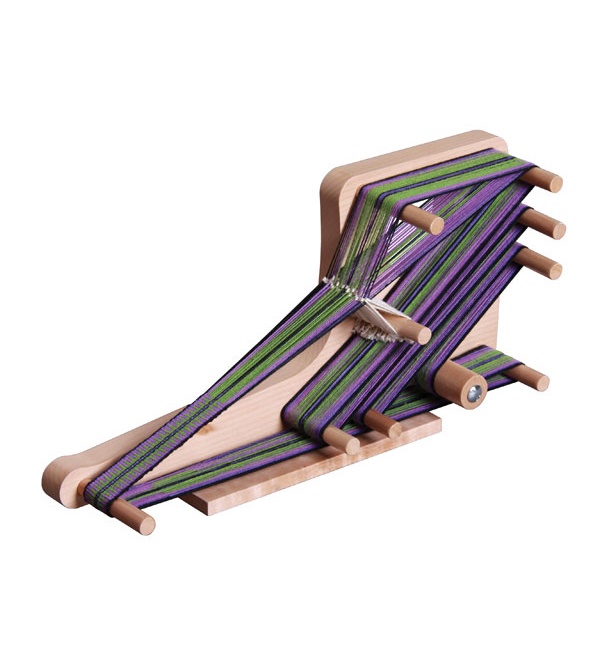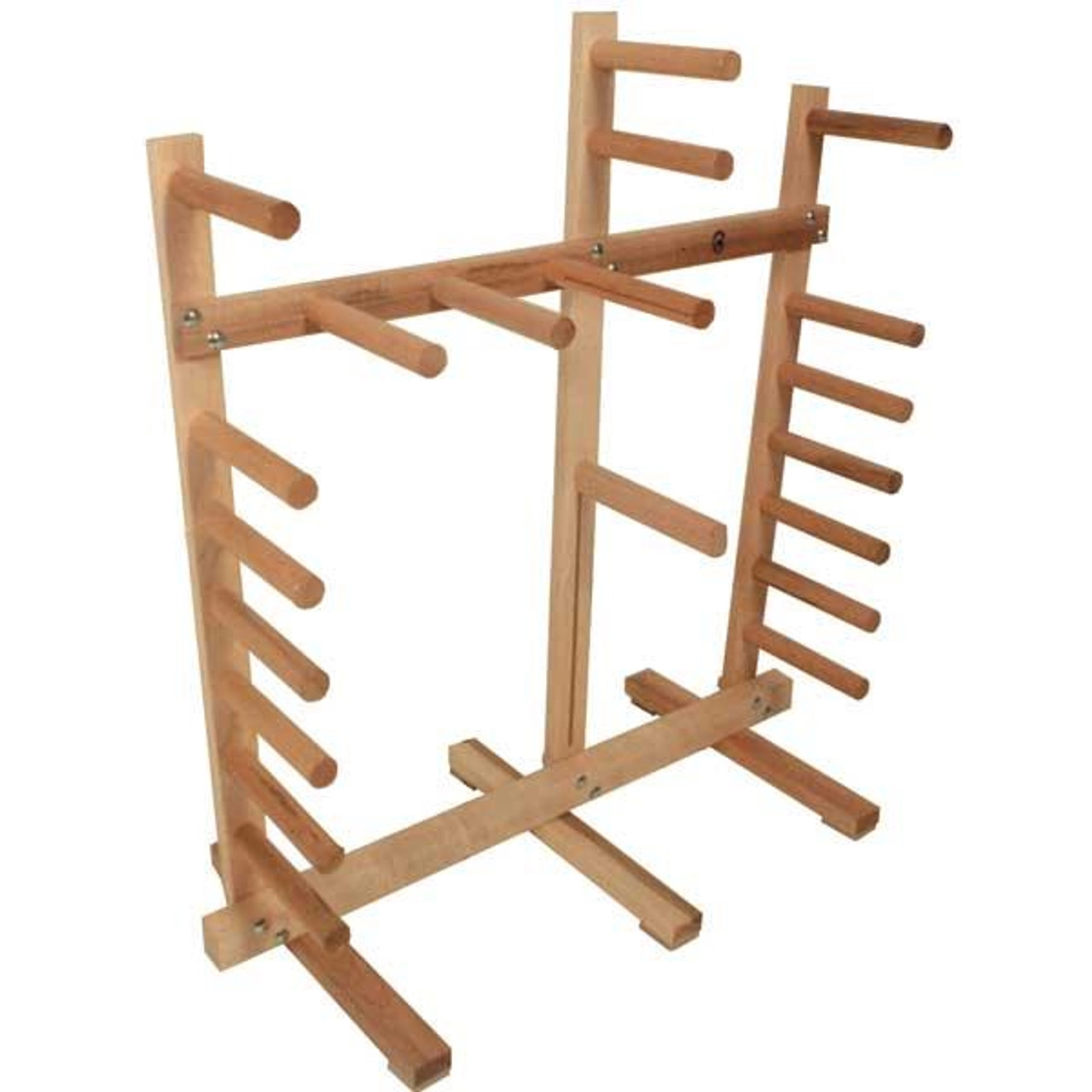Loom Spotlight: Inkle Looms
equipmentInkle looms are designed for weaving warp faced bands - think belts, guitar straps, dog leashes, and trim for other pieces. They consist of pegs sticking out of a frame and are usually made of wood; usually they have a frame on one side, but some designs provide additional support by having a removable 2nd side to the frame. One peg is moveable to adjust tension, and the shed is created by the weaver pushing the warp up and down with their hand.
The "default" for inkle looms is to set up string heddles, with half the yarns in a heddle and half not. They can also be used for other styles of band weaving, such as with a small rigid heddle or cards for tablet weaving. A lot of interesting patterns can come out of simply the color choices of the warp, but even more elaborate patterns can be made using pick up or tablet weaving. Rigid heddles for band weaving are more often made of wood and sometimes include extra holes or different sizes of slots to make certain patterning easier, and they're usually smaller and lighter than the ones on rigid heddle looms.
They can be fairly small, like the Ashford Inklette, which can weave up to 2" wide and 70" warp (just under 6'), or they can be quite large and rest on the floor, like the Leclerc Cendrel, which can weave up to 6" wide and 16 feet long, and is also designed for use as a warping board for other looms; but most are in between. When choosing a loom, remember that the finished length will be shorter than the warp due to take up and loom waste.
Among major weaving manufacturers, Ashford, Schacht, and Leclerc make inkle looms, and there are also many made by smaller woodworkers selling on places like Etsy or at local fiber events, some with elaborate designs on the frame or a wider selection of sizes. Inkle looms are relatively straightforward to make with some woodworking experience and tools; I have also seen designs made out of PVC pipes.
The term "inkle" dates back to the 1500s and refers to any ribbon or tape. While band weaving is ancient, the current style of inkle loom, while simple, is a relatively modern innovation dating to perhaps the 18th or 19th century, with the smaller table top versions being newer. Band weaving can also be done using backstrap techniques, or held between any two points like a bow loom. There's also a style of "box loom" or "tape loom" that is a precursor to modern rigid heddle style looms which were designed for weaving bands with an unsupported rigid heddle, and there are some treadle looms designed for band weaving, such as the Swedish Band Loom.
Weaving on an Inkle Loom #
Inkle looms are warped in a circular pattern, and there's no separate step to measure the warp. Color changes are knotted together at the beginning of the warp, and yarns pass through a string heddle or not as it's being warped. The length of the warp is dictated by the exact path between the pegs - a given loom will have a maximum and minimum length, and some options in between. For example, the Ashford Inkle Loom can do warps of between 1.3-2.8 meters (51-110").
Inkle weavers typically use a small stick shuttle with a beveled edge for the weft, sometimes referred to as a belt shuttle, and use the shuttle to beat the weft in firmly, however, some prefer to use a separate tool known as a band knife. To advance the warp, inkle weavers loosen the tension peg and pull on the warp, and then re-tighten the tension.
What can you make on an Inkle loom? #
Inkle looms make narrow warp faced bands from shoe laces to a wide belt. Bands can be used as is, have hardware added like a belt buckle, used as edging, trim, or straps on other weaving or sewing projects, or can be joined together or to a backing fabric to make larger items, like this pouch from the Ashford blog. It's also possible to make tubular structures on an inkle loom. Little Looms Magazine, which has many rigid heddle projects, also typically includes some inkle projects with each issue.
General Pros and Cons of Inkle Looms vs Rigid Heddle Looms #
Inkle looms are fantastic simple tools for weaving bands, and they're generally cheaper and smaller than small rigid heddle looms (excepting the larger floor standing models!). However, they're also a specialized tool - they're good at weaving bands, but that's pretty much all they do, so if you only intend to weave the occaisonal band a more general purpose rigid heddle loom or using backstrap techniques may suit your needs better. While many people prefer band weaving on an inkle loom, I have also come across who prefer using a rigid heddle loom for that purpose.
Price wise, most inkle looms are cheaper than most rigid heddle looms. The Ashford Inklette currently retails for under $70 USD, and the Schacht and Ashford mid-size Inkle looms are both under $120 USD and are cheaper than any Rigid Heddle loom.
A small inkle loom like the Ashford Inklette is extremely portable, taking up less space than a folded Ashford Knitter's Loom other than being slightly thicker at 4.5"x14.5"x7.25", while a "mid size" inkle loom like the Ashford Inkle loom is about as long as a full size rigid heddle loom while being smaller in other dimensions, at 6.35"x25.5"x11.25".
In my personal experience, I found my Sample-It rigid heddle loom was difficult to use with cards due to it's short length and the location of it's cross beam, and I also had some difficulty with my attempts to get a truly warp faced band with neat edges using the heddle, however that may be due to inexperience! The Sample-It is a fairly short rigid heddle loom and you may get different results with a different loom.
Because inkle looms are warped in a circular fashion, where the beginning and the end of the warp meet, there tends to be less loom waste than on a rigid heddle or most other styles of looms where yarns are tied on at both ends.
Inkle vs Rigid Heddle as a starter loom #
Either style of loom can make a great starter loom depending on your interests! Inkle is cheaper and limited to making narrow items, but there's a wide world to explore with making bands!
An inkle loom can be a great complement to a larger loom, so if you're not sure about weaving and want to try out a lower cost option first it's a great starting point that can then be used to enhance other weaving in the future. Inkle woven bands can be used as straps for a bag, hanger loops for towels, or trim for many kinds of weaving projects. Some inkle looms can also be used as a warping board for another loom, or, with a rigid heddle loom for hybrid warping.
- Next: Loom Spotlight: Backstrap Looms
- Previous: Loom Spotlight: Frame Looms
Check out Not So Rigid Designer, the online weaving software for rigid heddle loom weavers!


